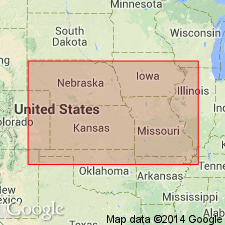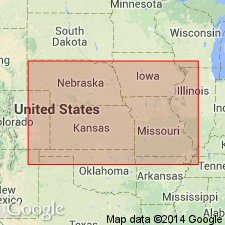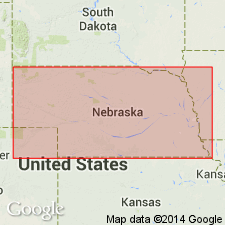
- Usage in publication:
-
- Schubert Creek limestone member
- Modifications:
-
- Principal reference
- Dominant lithology:
-
- Limestone
- AAPG geologic province:
-
- Cherokee basin
Summary:
Pg. 100, 103. Schubert Creek limestone member of Swope formation of Bronson group. Limestone, rather light in color, crystalline, and generally brecciated. Thickness from a few inches to 15 feet. Lowest member of Swope formation. Age is Late Pennsylvanian (Missouri age).
Type locality: on Schubert Creek, between Bronson and Uniontown on U.S. Highway 54, Bourbon Co., eastern KS. Present along "line of outcrop" of Bronson group, from T. 22 S. to T. 28 S.
Source: US geologic names lexicon (USGS Bull. 896, p. 1942).

- Usage in publication:
-
- Schubert Creek limestone member
- Modifications:
-
- Overview
Summary:
Pg. 90, 97. Schubert Creek limestone member of Swope limestone of Bronson group. As described elsewhere in this guidebook by Jewett, the lowermost formation of Bronson group includes 3 limestone lentils which are named (ascending order) Schubert Creek, Critizer [Critzer], and Sniabar. The Schubert Creek limestone was apparently studied by Hinds and Greene (1915, Missouri Bur. Geol. and Mines, v. 13) in vicinity of Uniontown as a supposedly authentic representative of "Hertha" limestone in Kansas, and this rock was correlated by them with the prominent limestone that appears next below Bethany Falls limestone in Kansas City and northwest Missouri district. Latter bed is now called Sniabar. Age is Late Pennsylvanian (Missouri age). [See also under Swope limestone.]
Source: US geologic names lexicon (USGS Bull. 896, p. 1942); GNC KS-NE Pennsylvanian Corr. Chart, sheet 2, Oct. 1936.

- Usage in publication:
-
- Schubert Creek limestone†
- Modifications:
-
- Abandoned
Summary:
Pg. 80. Discarded Schubert Creek limestone. (See under Critzer limestone.) He appears to include it in his Bourbon formation.
Source: US geologic names lexicon (USGS Bull. 896, p. 1942); GNC KS-NE Pennsylvanian Corr. Chart, sheet 2, Oct. 1936.

- Usage in publication:
-
- Schubert Creek limestone†
- Modifications:
-
- Abandoned
Summary:
Pg. 41. Name introduced by [Jewett] for lower member of Hertha. Later it was found that this limestone is the one called Hertha at Kansas City. Kansas Geological Survey now uses names Sniabar limestone, Mound City shale, and Critzer limestone as members of the Hertha.
Source: US geologic names lexicon (USGS Bull. 1200, p. 3499).
For more information, please contact Nancy Stamm, Geologic Names Committee Secretary.
Asterisk (*) indicates published by U.S. Geological Survey authors.
"No current usage" (†) implies that a name has been abandoned or has fallen into disuse. Former usage and, if known, replacement name given in parentheses ( ).
Slash (/) indicates name conflicts with nomenclatural guidelines (CSN, 1933; ACSN, 1961, 1970; NACSN, 1983, 2005, 2021). May be explained within brackets ([ ]).

